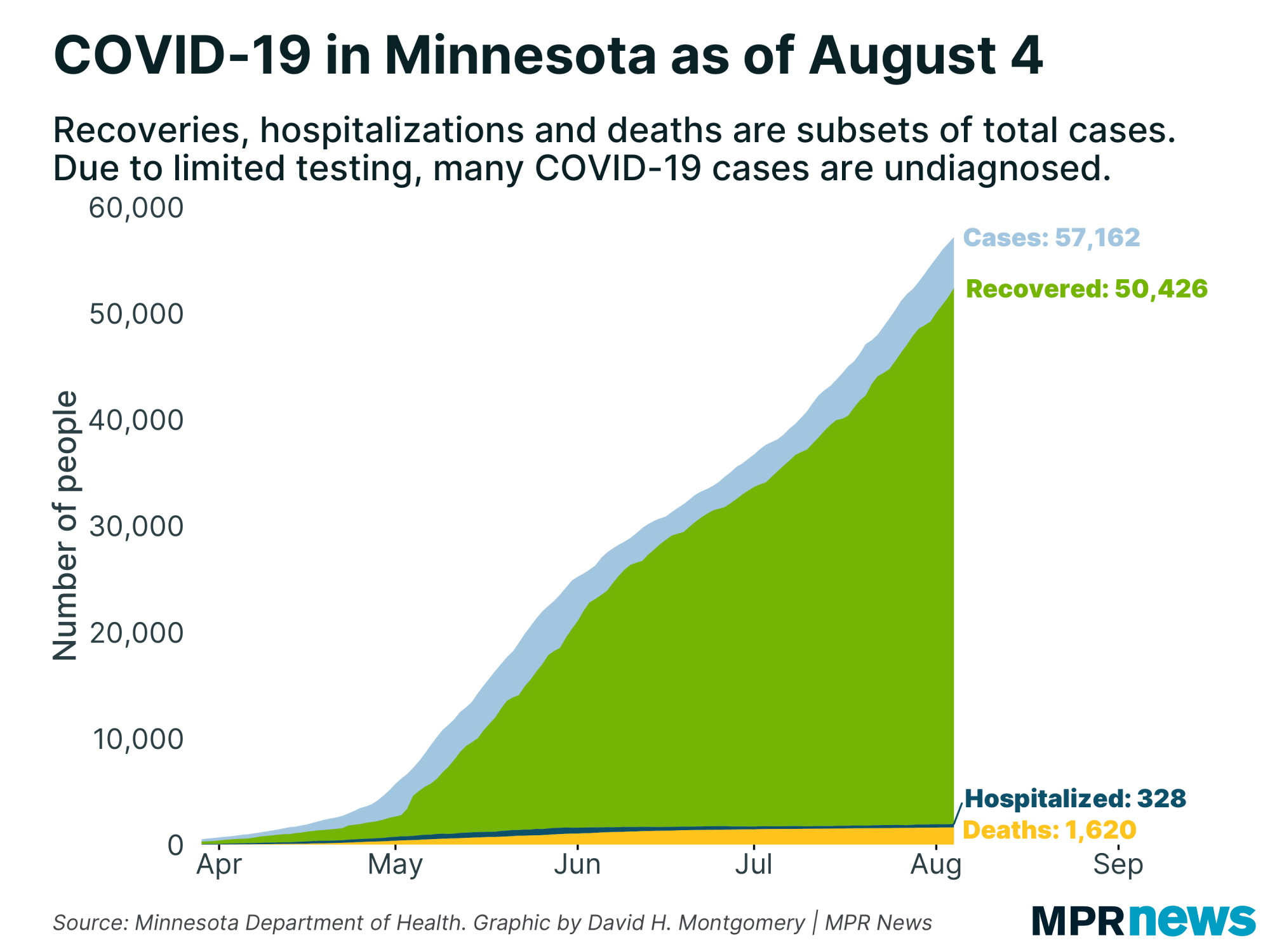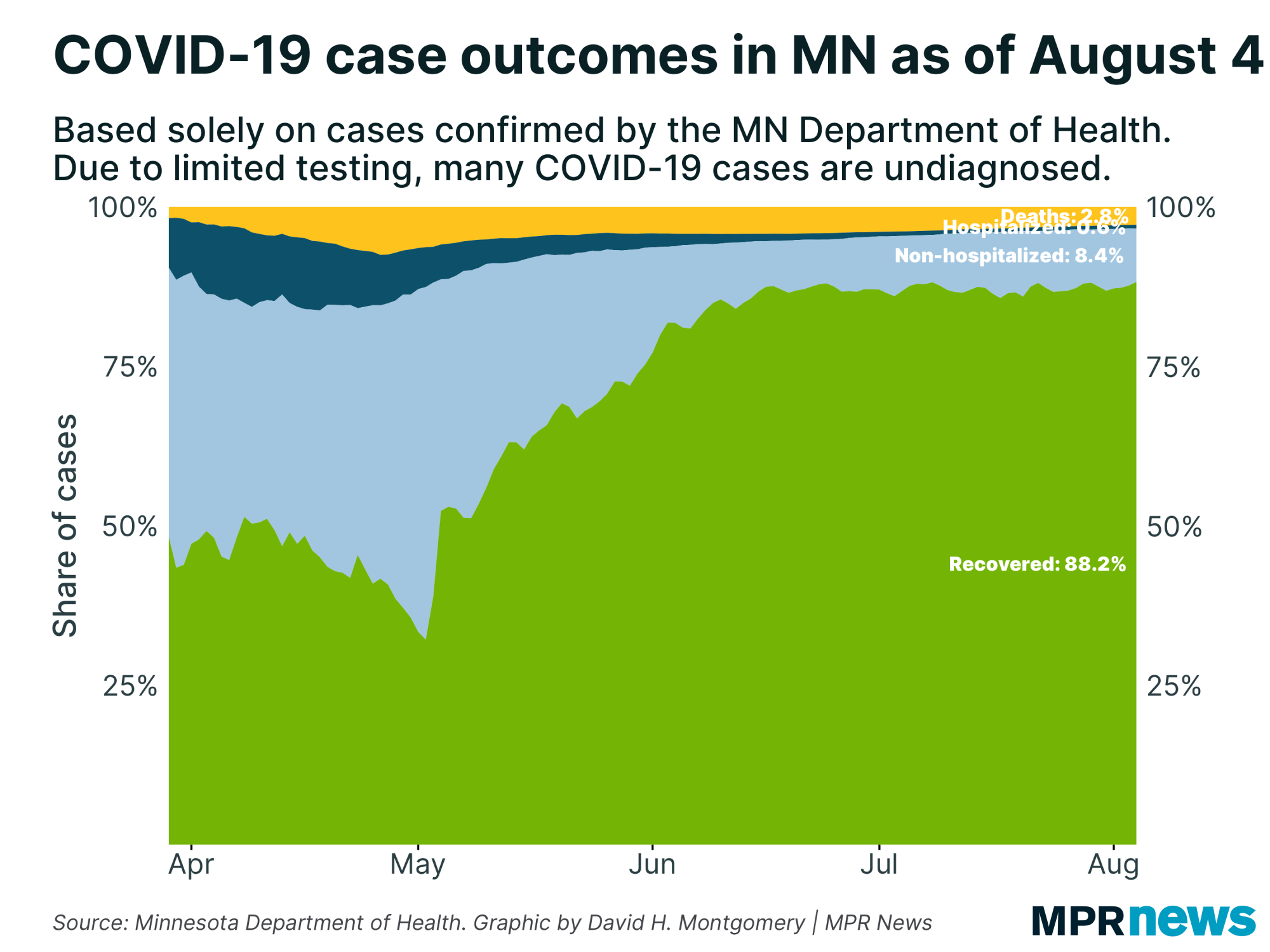May 10 update on COVID-19 in MN: Death toll in Minnesota climbs to 578

Go Deeper.
Create an account or log in to save stories.
Like this?
Thanks for liking this story! We have added it to a list of your favorite stories.
Updated: 11:43 a.m. | Posted: 10:26 a.m.
Minnesota reported 20 more confirmed COVID-19 deaths on Sunday, bringing the overall death toll in the state to 578.
The overall number of confirmed cases increasing by 481, for a total of 11,271. The state reported results from 4,825 tests on Sunday — that's short of Gov. Tim Walz's goal of testing 5,000 people daily as part of the plan to reopen the economy.
Minnesota health officials on Friday said the state now has the capacity to run 10,000 tests a day for COVID-19, but the state isn’t yet reporting testing totals anywhere near that level.
State Health Commissioner Jan Malcolm said the lower-than-expected testing could be because of earlier messaging to the public that tests were limited because of a lack of supplies.
Turn Up Your Support
MPR News helps you turn down the noise and build shared understanding. Turn up your support for this public resource and keep trusted journalism accessible to all.

"Testing’s available, and providers are telling us that people aren’t coming in. So people aren’t availing themselves of the testing capacity that’s there," Malcolm said Friday. "And we need to do better. We need to do more outreach to make sure people know they can and should be getting tested if they have symptoms."
You can find testing sites for COVID-19 by going to mn.gov/covid19.
The number of people still hospitalized with COVID-19 as of Sunday is 434. Nearly 200 of those patients are being treated in ICUs.
More than half of Minnesotans who've been diagnosed with COVID-19 have recovered to the point where they no longer need to be in isolation.
Here are the latest coronavirus statistics as of Sunday:
11,271 confirmed cases via 111,088 tests
578 deaths, up from 558 on Saturday
1,612 cases requiring hospitalization, up from 1,549 on Saturday
434 people remain hospitalized (down from 476 Saturday); 199 in intensive care (up 19 from Saturday)
6,882 patients recovered to the point of no longer needing isolation, up from 6,322 on Saturday

Overall, a Friday briefing by state officials offered a sobering reminder that even as Minnesota inches back toward normalcy, the fight against the disease is nowhere near done and the damage done is nowhere near complete.
“What I don't think has sunk in yet, this thing is going to be with us at least until we get really good therapeutics, or we get herd immunity, or we get a vaccine,” said Walz.
Malcolm on Friday said the federal government is sending Minnesota small amounts of remdesivir, an experimental drug that has shown promise in treating COVID-19 patients.
Economic, health toll falling hardest on people of color
State officials continue to reiterate growing concern about COVID-19’s effects on the state’s communities of color.
On Thursday, Malcolm noted worrisome illness trends among care workers in congregate care, noting that workers of color were falling ill at relatively high rates. African immigrants make up a “critical part of the workforce,” Malcolm said. “We can see with this data that they are being quite disproportionately affected as well.”
On Friday, she noted people of color are showing up disproportionately in the count of COVID-19 cases and hospitalizations. Black Minnesotans, for instance, make up about 6.6 percent of the overall population but nearly 17 percent of confirmed COVID-19 cases and 19 percent of hospitalizations, she said.
Lt. Gov. Peggy Flanagan noted that many black and Latino citizens are in jobs that make them vulnerable to exposure, “exposing and exacerbating … inequities that have been here all along.”
Economically, Flanagan said more than 25 percent of people of color in the state’s labor force are seeking unemployment benefits. That includes nearly 1 in 3 black Minnesotans in the labor force.
Meatpacking remains at the center of case jumps
Many of the recent outbreaks outside the Twin Cities metro area are focused around meatpacking plants. Officials have intensified testing in those hot spots, uncovering more infections.
In southwestern Minnesota’s Nobles County, where an outbreak hit Worthington’s massive JBS pork plant, about 1 in 18 people have tested positive for COVID-19. In mid-April, there were just a handful of cases. On Sunday, there were 1,255 confirmed cases; the numbers were still increasing, though at a slower rate than in previous weeks.
The JBS plant shut on April 20 but partially reopened Wednesday with expanded hygiene and health monitoring measures.
Similar problems have been reported in Stearns County, where COVID-19 cases tied to two packing plants — Pilgrim’s Pride poultry plant in Cold Spring and Jennie-O Turkey in Melrose — have skyrocketed. An undisclosed number of workers at both plants have tested positive for the virus.
There were 589 confirmed cases in Stearns County to start last week. And by Sunday confirmed cases had jumped to 1,405, surpassing Nobles County.
Kandiyohi County in west-central Minnesota is also seeing cases jump two weeks after officials with the Jennie-O turkey processing plant there said some employees had tested positive for the coronavirus. The county had confirmed three COVID-19 cases back then. On Sunday, the Health Department reported 284 people have now tested positive.
Developments from around the state
MN Zoo cuts 125 jobs as its doors shut amid pandemic
The Minnesota Zoo is laying off 48 employees and eliminating dozens more positions. In all, more than 125 positions are being eliminated.
In addition to the layoffs, several open positions are not being filled, and dozens of seasonal jobs will be suspended. The Minnesota Zoo's partner organization, the Zoo Foundation, is also laying off four employees.
In a press release, Zoo director and Foundation president John Frawley said the global pandemic has created a situation unlike any other in the zoo's 42-year history. He said animals will continue to receive exceptional care while the zoo is closed to the public. Affected employees were notified this week.
— Marianne Combs | MPR News
MN House backs aid for low-income Minnesotans, small business owners
The Minnesota House on Thursday passed legislation to help many people with low incomes and small business owners get through the COVID-19 pandemic. The vote was 75-58.
The bill includes money for emergency housing assistance, rural broadband and small business loans. It also has temporary pay raises for the personal care assistants who care for the elderly and disabled. The $208 million measure would be partially paid for with recently received federal funds related to COVID-19.
DFL House Majority Leader Ryan Winkler, of Golden Valley, said the assistance is critical.
“Those workers, those families, those businesses are essential to our state, and Minnesota has to act to help them get through this crisis,” Winkler said. “If we do nothing, if we let them fall through the cracks and be left behind, we are going to have a much, much slower economic recovery afterward.”
House Republicans argue that with a large budget deficit ahead, the bill is not affordable. But Republican House Minority Leader Kurt Daudt, of Crown, and other Republicans argued that a better approach would be allowing businesses to reopen.
“The best thing that you can do is [to] allow these businesses to open up safe,” Daudt said.
Senate Republicans are trying to provide help through a package of tax breaks.
— Tim Pugmire | MPR News
Top headlines
Guthrie announces drastic cuts to budget, upcoming season: The Guthrie Theater in Minneapolis has drastically scaled back its plans for the next season of plays, and says there will be staff cuts and layoffs as its budget for the upcoming season has been reduced by 60 percent.
Minnesota American Legion cancels 2020 baseball season: This summer — for the first time in more than 90 years — there won't be an American Legion baseball season in Minnesota. Legion baseball officials announced Saturday that they're canceling the 2020 season out of safety concerns for players, coaches, umpires and fans amid the COVID-19 pandemic.
Minn. education officials urge virtual ceremonies for graduating seniors: Officials with the Minnesota Department of Health joined state education commissioners for K-12 and higher ed Friday morning to announce guidelines encouraging schools, colleges and universities to host remote graduation ceremonies for the class of 2020. Large, in-person gatherings won’t be allowed.
School leaders, families struggle to plan for summer and fall learning: Superintendents say they’ve already begun moving ahead with plans for their students in the summer and fall, but remain ready to change if state leaders continue to forbid in-person learning.
Deaths in nursing homes spur officials to increase testing, bolster staff levels: As the number of deaths in long-term care facilities from COVID-19 has grown, so too has the pressure to address the issue. Minnesota officials say they have a new plan to try to get a better handle on the problem after hundreds of older adults have died.
COVID-19 in Minnesota
Health officials for weeks have been increasingly raising the alarm over the spread of the novel coronavirus in the United States. The disease is transmitted through respiratory droplets, coughs and sneezes, similar to the way the flu can spread.
Government and medical leaders are urging people to wash their hands frequently and well, refrain from touching their faces, cover their coughs, disinfect surfaces and avoid large crowds, all in an effort to curb the virus’ rapid spread.
The state of Minnesota has temporarily closed schools, while administrators work to determine next steps, and is requiring a temporary closure of all in-person dining at restaurants, bars and coffee shops, as well as theaters, gyms, yoga studios and other spaces in which people congregate in close proximity.


